#pycnofibers
Photo

Rhamphorhynchus 01
Late Jurassic, Europe
A pair of Rhamphorhynchus pterosaurs in the first light of dawn.
Made in Blender.
#paleontology#paleoart#pterosaur#Jurassic#late jurassic#Rhamphorhynchus#rhamphorhynchoid#rhamphorhynchid#pycnofibers#dawn#dusk#Nathan E. Rogers#blender#3d#prehistoric#solnhofen
36 notes
·
View notes
Text

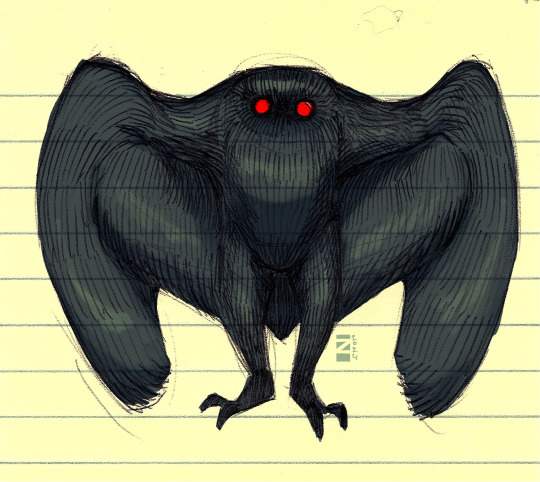
Couples See Man-Sized Bird…Creature…Something!
a few mothman sketches to celebrate us finally running into it in our Delta Green campaign. surely this isn't an omen of anything
#mothman#cryptid#delta green#operation: silent mountain#obsessed with drawing mothman like it's 2016 again. getting back to my roots#i don't imagine it having feathers. it's covered in smooth thick fur like an otter or pterosaur pycnofibers#over stretchy membranous ''wings'' like a colugo#sketch#roz can have little a specbio. as a treat#obviously in this case i don't think it's an actual biological organism but we don't know much about it yet#artists on tumblr
245 notes
·
View notes
Photo
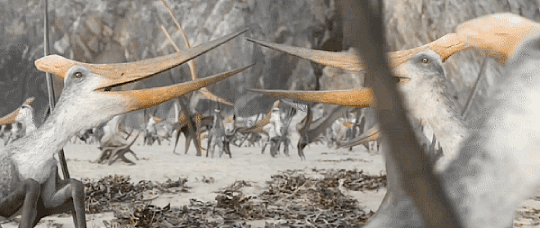





One kind of animal thrives in such places and forms immense colonies. Flying reptiles. Pterosaurs. Here, on the beaches of North Africa, there are seven different species of them. They come here to feed, to rest, and to raise their young. Tethydraco are well-adapted to spend time on the ground, and not only make their nests here but stay to protect their brood. And their young certainly need protection. The dagger-beak, Phosphatodraco, a 9-foot-tall predator that stalks through these colonies, looking for the chance to snatch an unguarded hatchling.
#prehistoric planet#documentaryedit#my edit#/loved/ how they created the pterosaurs <3 the pycnofibers <3 the plantigrade feet <3
243 notes
·
View notes
Text
You know what? Pterano is adorable actually. ❤️
#idgaf what anyone says anymore tbh#dude ive been guilt-tripped by other lbt fans for adoring Pterano (the character) and my brain has basically held on to that but no more#he is precious and adorable and fuck you for guilting me for talking about him 'too much'#especially when he gets all flustered#imagine if they gave flyers pycnofibers#cuteness overload#he's so precious ❤️❤️❤️❤️❤️❤️❤️#no i will not elaborate
3 notes
·
View notes
Text
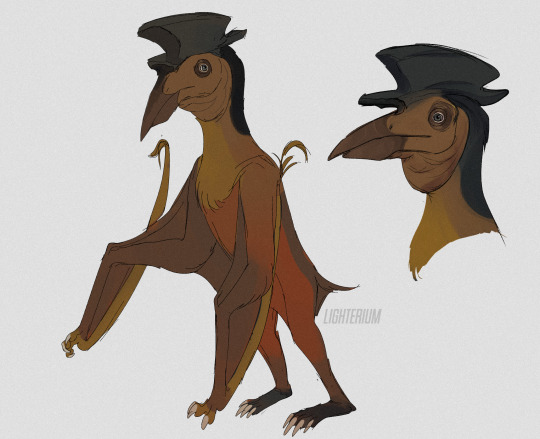
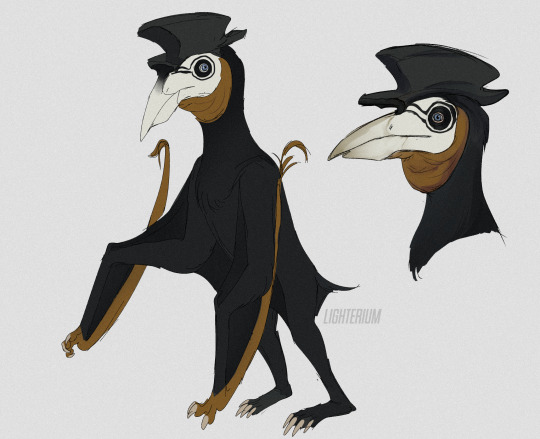
Plague doctors, beasts with too-human eyes that visit places that carry a heavy scent of carrion and disease. They accidentally spread more plague as their pycnofibers are excellent for tics to cling on. They seem immune to the disease itself.
It's said that the reason they smell like flowers is because they supplement their diets with them and rub their beaks with petals, for an unknown yet reason. Some argue its to attract mates, others that some flowers have antibacterial properties
some inspirations for their designs!

Wightia art by Dan Folkes
444 notes
·
View notes
Note
are pycnofibers and feathers the same structure just diverged early on?
Short answer: Maybe, but really the question is kinda unanswerable currently
Long answer: The answer to this are built on not just one maybe, but multiple layers of maybes. To start with, in case anyone's unfamiliar, let's talk about analogous and homologous structures. In evolutionary biology, a physical feature is homologous if it is shared between two species, and the common ancestor of those two species also had that feature. A common example is that the arm of a human and the wing of a bird are homologous, because we share the same pattern of bones and our distant common ancestor had those same bones!
On the other hand, a physical feature is analogous if it has a shared function, and it may or may not share an evolutionary origin! So for example, a bat's wing and a bird's wing are both analogous (same function, powered flight) and homologous (same bone pattern shared with common ancestor). A bird's wing and a dragonfly's wing, however, are analogous, but are not homologous (they do not share an evolutionary origin).
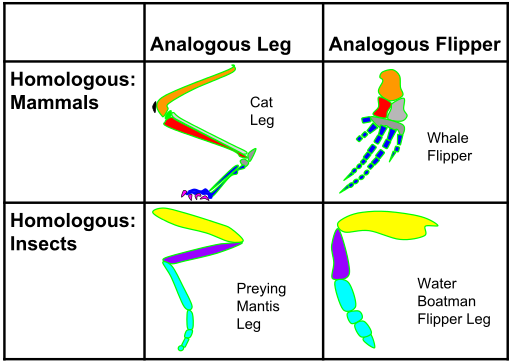
This table sums it up in a way that I find helpful, comparing analogous structures in insects and mammals. Via Wikimedia Commons.
So, the fuzz on dinosaurs and pterosaurs are pretty evidently analogous structures. They provide the same functions: temperature regulation, probably display, possibly smoothing the body's silhouette in flight? But the key question is, are they homologous? Did the common ancestor of pterosaurs and dinosaurs also have fuzzy structures?
Now, let's get to those multiple layers of maybes, starting with the issue of whether even dinosaurs had a fluffy common ancestor. We see evidence of filamentous structures in both theropods and ornithischians. These structures maybe come from the same evolutionary origin, and if they do, then the common ancestor of all dinosaurs right at the base of the tree also had filaments. As far as I'm aware, whether or not this is likely is a fairly subjective matter, but as you can probably tell from my palaeoart I lean towards the idea that dinosaurs were ancestrally fluffy.
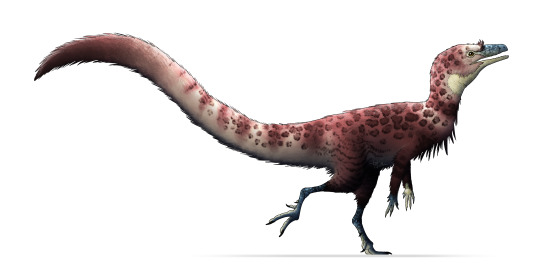
This little fellow, Lagerpeton, is one of the closest things to a dinosaur that isn't actually a dinosaur. If the ancestor of all dinosaurs was feathery, this guy probably was too!
If dinosaurs were ancestrally fluffy, then maybe the filaments of dinosaurs and pterosaurs come from the same evolutionary origin. If ancestral dinosaurs were fuzzy, that puts two very closely related lineages of fuzzy archosaurs very close together in time, some point in the Middle Triassic probably. If that's the case, then it makes sense that the common ancestor of these two groups was probably fuzzy.
However, you'll probably notice that this hypothetical scenario where ancestral fuzz is likely is constructed on top of the assumption that dinosaurs were ancestrally fuzzy, which is something that's still not fully proven. It's not even certain that all dinosaur fuzz is homologous, which makes pterosaurs tricky.
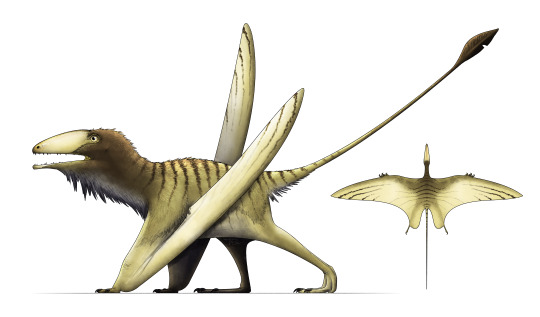
Even whether the earliest pterosaurs, like Peteinosaurus, had pycnofibres is currently only a matter of hypothesis!
The reality is the evidence which would most easily resolve the mystery currently does not exist. If, say, a Triassic dinosaur and Triassic pterosaur were discovered with fuzzy filaments then that would basically confirm that these two very close groups we both ancestrally fuzzy. Even better still would be some basal avemetatarsalian from the Middle Triassic with preserved fluff. That's basically like asking for the Holy Grail though, a genuine common ancestor of pterosaurs and dinosaurs.
Unfortunately, the oldest records we do have for feathered dinosaurs and pycnofibred pterosaurs stop at about the Middle Jurassic. Any older than that, and we lose the sites with immaculately fine silt grains that preserve soft tissue like feathers. That's not to say a future beautiful Middle Triassic silt bed couldn't show up, and oh boy I really hope one does eventually, but for now there's simply nothing out there to offer concrete proof.

Jeholopterus, an anurognathid pterosaur from the Middle to Late Jurassic of China, preserved with evidence of pycnofibres. Via Wikimedia Commons.
So in the absence of this proof, what do we do? I'd consider Occam's Razor a decent guiding principle here, although it's less reliable in some other areas of evolutionary biology. Occam's Razor basically states that the most reasonable explanation is one that doesn't unnecessarily multiply the entities of a problem.
To put it another way, it seems more reasonable, in an evolutionary sense, that three closely related groups (ornithischians, theropods, and pterosaurs) got their fuzziness from one fuzzy common ancestor. The alternate explanation is that two (or possibly three) very closely related groups all independently evolved remarkably similar feathery coats from being initially scaly.
Occam's Razor isn't foolproof, and there's a reason that we have the term convergent evolution, but in this case I think we should consider it a reasonable guess that the common ancestor of dinosaurs and pterosaurs had some sort of fluffy filaments, and that feathers and pycnofibres are indeed homologous.
But just to be clear, this is not the answer!! This is a best guess, a hypothesis based on available lines of evidence that disappear in the crucial stages of its evolutionary history, and the application of a logical rule of thumb to cap it off. Just because that's the side I lean towards, doesn't mean that the issue is settled or that I wouldn't change my perspective if new evidence came to light. That's the great thing about science after all!
So, I do hold to my original statement that right now, this question is not truly answerable (even though I've now spent almost 1000 words trying to answer it). We can guess and hypothesise, but for now the real answer remains out of reach.
#pterosaur#dinosaur#paleontology#paleoart#palaeoblr#science#science communication#long post#scicomm#prehistoric#fossils#feathers#feathered dinosaurs#biology#evolution#natural history
1K notes
·
View notes
Text
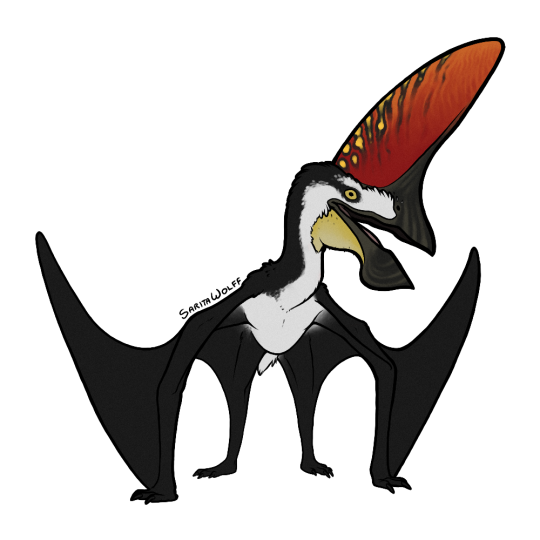
#Archovember Day 3 - Tupandactylus navigans
There were at least two species of the Tapejarid pterosaur Tupandactylus: T. imperator (who I’ve drawn previously) and T. navigans. Of the two, T. navigans is smaller, with a straighter, more upright crest. (A 2021 study suggests that the two species could actually represent sexually dimorphic members of the same species, but more detailed study is required to support this.) Either way, Tupandactylus is known for its huge keratinous crest, and T. navigans especially for its sharp shark-fin profile. This large crest likely limited T. navigans’ flight ability, relegating it to spending most of its time on the ground, only taking short flights to evade predators.
In 2022, A specimen of Tupandactylus imperator was discovered to have very complex branching pycnofibers (feather-like filaments unique to pterosaurs) that were much closer to true feathers than previously thought possible in pterosaurs. This could be further evidence that feathers are a basal trait to Avemetatarsalians. Also, similar to Anchiornis, Tupandactylus has been found with preserved melanosomes. However, paleontologists did not attempt to infer the color of the animal, but merely noted that the melanosomes were varied between the skin of the crest and the pycnofibers on its skull, probably providing some sort of contrast for the head ornamentation. No doubt imperator’s smaller cousin navigans was similar.
Living in Early Cretaceous Brazil, Tupandactylus navigans had a diverse array of frogs, lizards, and invertebrates to prey on, including moths, lacewings, mayflies, scorpions, and solifugids. T. navigans could have also preyed on small dinosaurs and their eggs, such as Enantiornithine birds and the compsognathid Ubirajara. T. navigans would have shared its environment with many other pterosaur species, such as its cousin T. imperator, Arthurdactylus, Aymberedactylus, Brasileodactylus, Lacusovagus, and Ludodactylus.

(As I’ve drawn T. imperator previously, but not with its own size chart, I’ve chosen to include it as a bonus here so the two species can be compared. I’ve also updated my imperator design a bit, as it was drawn before the 2022 study.)

#my art#SaritaDrawsPalaeo#Tupandactylus navigans#Tupandactylus#Tupandactylus imperator#tapejarid#pterodactyloid#pterosaurs#archosaurs#archosauromorph#Archovember#Archovember2023
50 notes
·
View notes
Text

Something about Luz reflection in the portal, but at the same time glimpsing the grave on the other side… I feel like there’s some meaning I should be able to derive from that. Um… I dunno, something about a dream dying? As in, Luz’ dream of a happy life in the Demon Realm dies here in the Human Realm or something.
Death as in permanence, as in Luz deciding to stay in the Human Realm permanently.
Luz feels dead inside.
(this is the kind of quality analysis you can only get here, at Lampman Liveblogs)

”I was scared… I thought you’d all hate me for it. Which is why I’ve made a decision. I think… that it’d be in everyone’s best interest if I-”
”Took your mama to the Demon Realm!”
Heck. Yes.
I think we’ve already established I’m all for that. Now Camila will finally get to meet Luz’ mentor and bonus mom Eda, her lil bro King, Hooty, cool aunt Lilith… oh, and The Collector! If anyone can tame a childish god, it’d be the woman who raised Luz.
I also appreciate that while Camila herself is not immune to making bad decisions, she will also keep her daughter from making bad decisions… granted, this is more like postponing the issues rather than actually solving them, but we’ll get there eventually, I’m sure.

HOL UP, wiat a mintue-
When did Hunter’s eyes change color!??!???? ANd how did I miss it?????
I rewound a bit, and it’s right there, when he wakes up and I just. Missed it. I can’t believe this. I’m an utter failure as a liveblogger and a person. As punishment, I will go on another four month hiatus which is only occasionally broken by posting a few low-quality memes and fanfics that no one will read.
(hey, Luz and Hunter ((and Camila)) have the same eye color now, that’s neat)
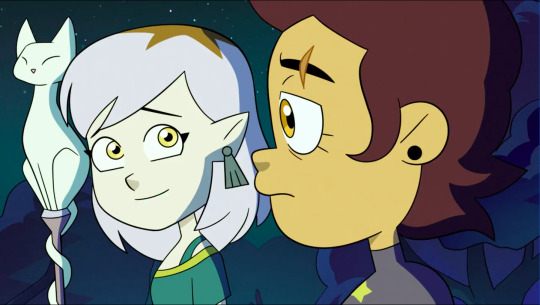
Pictured: Amity being the MOST awesome girlfriend that ever was an awesome girlfriend.
I mean, echoing Luz’ own words from when she asked Amity out is just next-level. so Hang on Sloopy, and let’s go get that bastard Belos.

Pictured: Me, ruffling my snake daughter’s pycnofibers.
Vee’s staying behind in the Human Realm, which… yeah, that makes sense. All her life spent in the Demon Realm was a nightmare. Things only started getting better for her when she came to the Human Realm. Hunter too had a hard upbringing (maybe putting it a bit lightly there), but he at least have some things there to fight for.
Oh, and minor detail, but confirmation that Camila does have living relatives back in the homeland.

And then they hit me with this rendition of the closing theme… it’s too beautiful

As the portal closes and Vee walks of smiling, sure that her family can handle this, we pan up to the beautiful night sky an-
”Shoot, Camila still has the car keys.”
…Vee gives the funniest line of the episode. I love the implication that if she just had the keys, Vee could totally drive the car back home. She is a basilisk/snake/legless lizard/naga of many talents.
24 notes
·
View notes
Text
LOOK! It's These Guys!
I drew my main characters. <3

Here's some fun facts about them.
Ptery's hair is LIKE FEATHERS. Soft, not quite pycnofibers and not quite feathers, but because of banshee origins is an amalgamation of hair and feathers. It can be styled, and most banshees to have a few feathers in their hair.
Meadow's left horn broke because two gods fought over him when he was 6 aurs (years) old and neither of them won. In a temper tantrum, the water god, Wheriae, broke his horn because Meadow wouldn't use water magic.
Benji is an archaeologist! Or he was, before he got wrapped up in stuff. He's made some pretty prominent discoveries, and his most recent area of study is old gnoll artifacts from the time of the Defeated (which the gnolls call the Old Gods.)
Everyone knows Luka's had some stress in her life. She has a grey streak behind her right ear. More interesting, though, is her bright green eyes. Most people suppose she has some elvish lineage. She's so abrasive that no one really asks about it.
You can get Shadecursed now on 4maz0n! It's available in eBook, paperback, or hardcover. If you'd prefer to have a signed copy, send me a message and I'll make it happen! Just do a search for Shadecursed and it should be the first result. <3
#writing#writer#indie book#indie fantasy#fantasy author#author#writeblr#fantasy novel#epic fantasy#fiction#speculative fiction#shadecursed#the bestiary#fauns#manticore#satyr#gnoll
10 notes
·
View notes
Note
do harpies consider physical conditions (like chronic pain conditions/joint issues) or anything resulting from injuries (like a traumatic brain injury or missing limb) worthy of being labeled with a part of eyto?
Not inherently! If those things happen to effect their behavior or personality then it will but physical conditions, injuries, disabilities and the like aren't considered flawed at a baseline. Harpy society is very maxxed out on scholarly pursuits too, anything an individual chooses to pursue no matter how significant it is is seen as crucial and important. They're probably the most set culture in the world for accommodating for physical disability.
That being said, obviously their caste system and decompartmentalizing away any minor negative traits is insanely detrimental. Traumatic brain injuries, learning disabilities, cognitive disabilities and neurodivergence, mental illness isn't viewed as Negative either, but they are things that effect how you process the world and react to it, meaning itd be harder for these harpies to fully remove traits seen as negative. harpies could be caste in wildly different ways even if they have the same condition right, but they're both still more susceptible to being misunderstood and caste negatively than a harpy without those issues. Obviously there's going to be an overlap with physical issues but if a harpy is physically disabled and behaves perfectly to the strict guidelines then they will not be caste if that's clear, same for the latter. If a harpy wjth cognitive issues does behave perfectly then they will not be caste either.
All the caste system really means is they won't be able to leave harpy home on field studies because they're not considered good representation of the species. And some social stigma but care still exists, they wouldn't go without good quality care and other harpies around them ect, especially in the same castes where their "negatives" are interpersonally forgiven and understood. You have to do a lot of purposeful bad to be outcast entirely here and most understand that there are many ways processing, decision making and emotional regulation can be effected between individuals.
I need to figure out the definitive list but atm it's roughly like this. Hands, tongue and teeth are the most common castes. Normally you're declared it by another harpy, it's cosigned by a couple witnesses to the behavior and you add some of thar body part visually to your clothes to signify. I imagine then the ones who declared you that clade will watch you for the next months until the original behavior is deemed fixed and you can return to normal status. Individual clade fashion and culture is built by the harpies who for one reason or another, have failed the assessment period consistently and are more or less permanently marked as that body part. They can live together but don't have to, they normally might just bc their strongest social connections are within their own castes ect. This system also doesn't downplay a harpies invidual research or make it less valid.
Tongue: impulsive speech
Teeth: cruel or abrasive speech
Hands: cruel physical action
Heart: selfish and uncaring for others
Brain: cunning in a worrying uncontrollable way
Guts: bold in a worrying uncontrollable way
Ect they go on for a while and would 100% get very specific, down to wing tips, specific feathers, pycnofibers, digits, molars, gristle, invidual bones ect ect.
Hope that makes sense! Im trying to hit a balance of this being a place that is largely Really detrimental but it is also what they know and theres going to be some nuance and good points within it. Anyway interesting ask thank you for sending it hehhehe.
9 notes
·
View notes
Note
You said we could ask about dinosaurs, what's your favourite/weirdest one? Also, do you think dino feathers are related to pterosaur fur? I'd love to imagine their common ancestor as a fluffy sillysaur-like creature :p
My favorite dinosaur flipflops between Dakotaraptor (potentially not valid & has the mess around its discovery, BUT was in a super cool ecosystem and is a real life JP Raptor) and Deinonychus (incredible fossils, revolutionized how we understand dinosaurs, the inspiration for those JP Raptors even if they slapped Velociraptor's name on the package). Because as fascinating as other species get, I'm a sucker for 'eagle-leopard-dragon'.
There's something just so cool about larger dromaeosaurids, even as it seems increasingly like most were not as social as we initially thought. I study social behavior in reptiles and can tell you that them not necessarily hunting in packs does not mean they didn't have fascinating intraspecific behaviors, and potentially social learning / gaze following / 'friendships' (here citing research in bearded dragons, red-footed tortoises and garter snakes, all of which are considered less socially / cognitively complex than birds. So I'd expect this as a bare minimum from most dromaeosaurids.)
My favorite weird dinosaur is actually harder to choose because there are so many of them. My current favorite is likely Jakapil, because I'm bitter it didn't win Dinosaur March Madness. You can read a bit more about it in @a-dinosaur-a-day's finalist post for it here! This thing has a super long ghost lineage, lived alongside one of the largest terrestrial predators to ever live, and just has such a funky look to it:

(Art credit to pantydraco on Twitter, which I 100% just chose because of the handle gkntrnh incredible)
Other weird favorites include Yi qui (dinosaur gave being a tiny dragon a try), Kulindadromeus (we'll get to it shortly) and Deinocheirus (giant-sloth-bear-duck, and its fossils also have their own incredibly weird story).
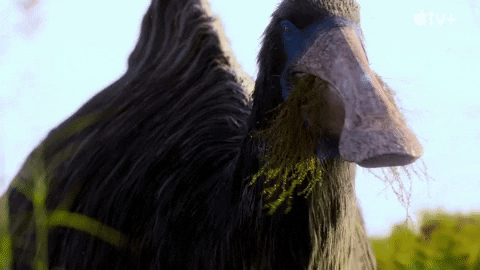
(I can't find who GIFed this and for that I am devastated, but it's from Prehistoric Planet's first season.)
To answer your second question, we don't actually call what pterosaurs have 'fur', given the implication that it'd be related to mammalian integument - the fuzz is called pycnofibers! Given that we see similar simple fibers in pterosaurs, theropods (see: the host of feathered dinosaur fossils, modern birds, a potential fuzzy pants trackway dated to the Triassic) and the ornithischians as well, I'd lean towards pycnofibers being basal to the group.
That weirdo I mentioned above, Kulindadromeus, is actually pretty instrumental to this - not only are its fossils absolutely insane (there are potentially hundreds of them in the bonebed! Including juveniles! Preserved with several types of scales!) but it was fuzzy! With three different types of fibers, too!
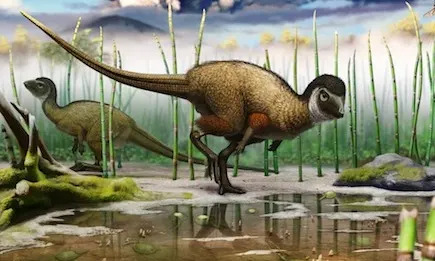
(Artist credit: Andrey Atuchin)
So the Triassic was likely rife with smallish not-quite-dinosaurs-not-quite-pterosaurs running around with floof, potentially to better deal with the harsh conditions. Or maybe just to look cute (this is half a joke gntrkntrknh)
#paleoblr#dinosaurs#Am I becoming a paleo-ish blog? :DDDD#all my reblogging of paleo content finally paying off baybyyyy#I wonder what the overlap between CR and dinosaur nerds is.#how many suffered with me at the wave of pronated arm T.rex!Caleb art after Rumblecusp and the boat fight
10 notes
·
View notes
Text
alright new fandom time
I mentioned in my last post that I’m a G-Fan now.
So… yeah the damn kaiju have grabbed hold of my autistic little brain.
Please accept this offering of a headshot of my Rodan design with pycnofibers.
Mostly based off Legendary’s design/how I always pictured him.
Please, let me know what you think in the comments below!

18 notes
·
View notes
Text

Day 15: Ice
It only seemed to be getting colder as we descended deeper and deeper into the caves. If I wasn’t wearing my helmet I know I'd be seeing my breath by now. It’s a sheer stark contrast from the desert we were in not too long ago. I wonder if we're still beneath the desert? If we’re headed south then I'm sure we are, but if we're headed north then there's a chance we could be back under the mountains by now. We’ve certainly been walking long enough.
Despite the increasingly scarce food web, no light, and biting cold, life is still thriving down here. We kept happening upon thin beds of a familiar white algae which clung to the cave walls. I'm not sure what it's using to fuel photosynthesis due to the total lack of sunlight down here, but nevertheless what little algae there is seems to be thriving. It's important to note that whenever and wherever there is a plant, no matter how badly the plant does not want to be eaten, something is going to eat it.
I saw, laying completely still on the cave wall, a long, almost salamander-like animal. Its eyes had completely atrophied into non-existence but its nostrils took up nearly half its face. While this animal must have been blinder than a bat, its sense of smell had to have been extraordinary. The base of its neck and tip of its tail were covered in thick, white fluffy pycnofibers while many pale blue osteoderms jutted from its back. I assume this is to help it blend into its surroundings, as its fluffy tail looks very similar to the white algae while the osteoderms resemble the shard of ice collecting on the cave walls. It's important to remember, however, if an animal is trying to blend in with its environment, then something must be actively trying to hunt it.
Despite being on some mystery animals menu, like cave animals on Earth, this creature has adopted a near sedentary lifestyle. I’d love to have observed it for longer, but the whole time I watched it, it never moved once. I do say near sedentary for a reason. Beneath its body and trailing behind it was a path of exposed blue cave stone carved out of the white algae bed. It's safe to assume this animal conserves as much energy as it can by rarely moving its body, all the while it slowly swivels its long neck back and forth to consume as much of this algae as it can, much the same way a caterpillar eats a leaf.
Unfortunately, we couldn’t stay very long. Our wisp guide had already begun to vanish down the tunnels and the last thing I wanted was to lose it. As we ventured further down the cave, we came across another one of these salamander-like animals. Its long, serpentine body was entangled around another smaller animal, both of which were long since dead. Observing the second species closer, its remains resembled a butterfly ray but with a vastly different skeleton.
Its bones appeared to be much more lightweight and hollow, more akin to avian bones than an ocean dwelling ray species, however, its skull consisted of much more study bone. While its foremost teeth jutted forward, it had multiple smaller rows that combed back like a shark's jaw. These countless, glass-shard like teeth must be constantly replacing themselves. This feature coupled with its bones and skull gave me the impression that this species of ray must fly around these caves looking for a meal. It then dive bombs its unsuspecting prey, teeth first, ensuring that its target has no chance at escape.
At first, I didn't even spot these two, Lily did. Their bodies were nearly totally engulfed in this white algae so that my view of them was completely obscured. It not only covered them, but it also radiated outward from the bodies with distinct lines and paths like a slime mold. It appears to me that this ray must have spotted the salamander as a potential meal, but it wasn’t expecting the ice salamander to put up such a fight. The ray, I assume, was the initial victor but couldn't free itself from the salamander's thralls and proceeded to suffocate. From there the white algae helped itself to the free meal.
Of all things, I wasn't expecting the algae to be the hunter down here. Yet cave life is always so unique and so it has to find unique ways of adapting. In an area with no sunlight there is no photosynthesizing, and so one would think there would be no plants. But Atria biology always plays by different rules. Countless animals on Atria’s surface have assumed the role and function of plants; they are completely sedentary and grow upwards and outwards to get the most sunlight for the algal colonies they farm. Because of this, it only makes sense that one of Atira's few true plant species could take on a more animalistic role. It sacrificed its ability to photosynthesize for the ability to scavenge and consume animal proteins with an efficiency unseen in plants on Earth.
[End Transcription]
3 notes
·
View notes
Note
Very sorry but pterosaurs did have feathers, not pennaceous ones like birds but iirc their pycnofibers are now considered to be true feathers. This also makes simple feathers (basically just fur but made of type b keratin) an ancestral trait of all ornithodirans
Yeah, I know. but they didn't have flight feathers nor feathered wings. That was the point I was trying to make.
5 notes
·
View notes
Note
What are some examples of convergent evolution in dinosaurs?
Ohhhh there's so many.
For anyone that doesn't know, convergent evolution is when creatures of different times develop the same features, even when they aren't related to each other.
Good examples of this are how birds, insects, bats and pterosaurs all evolved flight from different places. Or how like in the last ask, pterosaurs evolved pycnofibers similar to fur/hair. Or how we have like seven different families that evolved into crabs.
It can also be things like how sauropods and giraffes both evolved long necks, how ceratopsians, Ceratosaurus and modern rhinos have horns on their snouts, or how hadrosaurs had bills like ducks.
A smaller example of this, which is fascinating, is how three completely separate groups of dinosaurs evolved arctometatarsals. All three groups were accustomed to running: Tyrannosaurs, Ornithomimosaurs and Troodontids. What this trait does is take the pressure on the metatarsals and spread it evenly to prevent stress on the joint when running. It does this by pressing the proximal part (closest to the body) of the middle metatarsus between the other two, making it look squished.
Using rocks to help grind up food in the gut is also another good example. We know this occurs in modern birds, but also sauropods, elasmosaurs and, if you can believe it, earthworms!!
39 notes
·
View notes
Text

Smaugust 3 - Chiroptera colius
Last month I asked people to send me some of their favorite animals/plants/minerals. I'm now dragonizing the items on that list for Smaugust art prompts, attempting to draw one a day through the entire month. This one is based on the prompt "white-backed mousebird."
This small dragon snaps up insects on the wing and sips nectar from flowers . Hairlike pycnofibers insulate the body, while a spiny crest and scaley back defend from the talons of larger dragons
9 notes
·
View notes